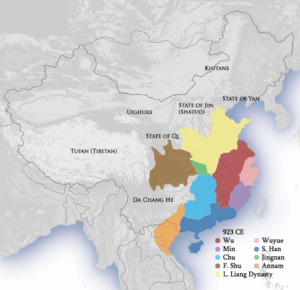Battle of Bạch Đằng (938)
| Battle of Bạch Đằng (938) | |||||||
|---|---|---|---|---|---|---|---|
 Map of Tĩnh Hải quân tiết độ sứ (靜海軍節度使) and | |||||||
| |||||||
| Belligerents | |||||||
| Jinghai Circuit | Southern Han | ||||||
| Commanders and leaders | |||||||
| Ngô Quyền |
Liu Yan Liu Hongcao † | ||||||
| Strength | |||||||
| unknown | 20,000[1] | ||||||
| Casualties and losses | |||||||
| unknown | 10,000[2] | ||||||
At the Battle of Bạch Đằng River in 938 near Hạ Long Bay in northern Vietnam the military force of the Vietnamese Principality of Jinghai, led by Ngô Quyền, a Vietnamese lord, defeated the invading forces of the Chinese state of Southern Han and put an end to centuries of Chinese imperial domination in Vietnam during the Five Dynasties and Ten Kingdoms period.[3] It was considered the turning point in Vietnamese history.[4]
Background[]
In October 930, Southern Han, a Chinese state in southern China during the Five Dynasties and Ten Kingdoms period, launched an attack on the Jinghai circuit, which at the time was a Vietnamese principality controlled by the Viet Khuc clan. The leader of the Khuc, Khuc Thua My, was taken prisoner by the Southern Han Emperor Liu Yan.[5] In 931, the local general Dương Đình Nghệ raised a 3,000-men army of retainers and drove the Southern Han back to the borders of the Jinghai Circuit.[6]
In 937, Đình Nghệ was assassinated by Kiều Công Tiễn, a formal military officer.[7][8] Đình Nghệ's son in law and also his general, Ngô Quyền, mobilized his army to overthrow Kiều Công Tiễn. Công Tiễn called Liu Yan for support. Liu Yan then put his son Liu Hongcao in command of the expedition, granting him the titles Jinghai jiedushi and King of Jiao, dispatching a fleet and sailing to the Gulf of Tonkin, headed inland up Bạch Đằng River, the water gate of Annam. Liu Yan himself led an additional force following his son's fleet.[6][9]
Battle[]
In late 938, the Southern Han fleet led by Liu Hongcao met Ngo Quyen's fleet on the gate of the Bach Dang River. The Southern Han fleet consisted fast warships carrying fifty men on each–twenty sailors, twenty five warriors, and two crossbowmen.[4] Ngo Quyen and his force had set up massive stakes tipped with iron foiled points on the river bed.[6] When the river tide rose, the sharpened stakes were covered by water. As the Southern Han sailed into the estuary, Vietnamese in smaller crafts went down and harassed the Chinese warships, lured them to follow upstream. When the tide fell, Ngo Quyen's force counterattacked and pushed the Chinese fleet back to the sea. The Southern Han ships now were stuck in the stakes and became immobilized.[4] Half of the Han army were killed and drowned, including Liu Hongcao.[6][10][11] When the news of the defeat reached Liu Yan on the sea by his survived soldiers, he learned that his troops were not lucky, and then retreated back to Guangzhou.[12]

Aftermath[]
In spring 939, Ngo Quyen proclaimed himself king and chose the antiquity town of Co Loa as the capital.[13][14] The Jinghai Principality de facto became independent, and Vietnamese history comes into its own.[15] Southern Han never attacked the Vietnamese again.[12] The tactics of Ngo Quyen would be reused by Prince Tran Quoc Tuan 300 years later against the Mongol-led Yuan invasion in 1288.[16]
See also[]
References[]
Citations[]
- ^ "Người kết thúc hơn một nghìn năm Bắc thuộc". baodanang.vn (in Vietnamese). Archived from the original on 2020-06-23. Retrieved 2020-06-23.
- ^ Bằng chứng cuộc sống: Suy ngẫm về phát triển bền vững Việt Nam (in Vietnamese). Nhà xuất bản Chính trị Quốc gia Sự Thật. 26 November 2015. ISBN 9786045720264., p. 8
- ^ Womack 2006, p. 113.
- ^ a b c Paine 2013, p. 314.
- ^ Taylor 1983, p. 263.
- ^ a b c d Kiernan 2019, p. 127.
- ^ Taylor 1983, p. 266.
- ^ Hall 1981, p. 215.
- ^ Taylor 1983, p. 268.
- ^ Ouyang 1995, p. 813.
- ^ Miksic & Yian 2016, p. 346.
- ^ a b Taylor 1983, p. 269.
- ^ Coedes 2015, p. 80.
- ^ Kiernan 2019, p. 139.
- ^ Kiernan 2019, p. 131.
- ^ Elleman 2019, p. 9-10.
Bibliography[]
- Coedes, George (2015). The Making of South East Asia (RLE Modern East and South East Asia). Taylor & Francis.
- Elleman, Bruce A. (2019), The Making of the Modern Chinese Navy: Special Historical Characteristics, U.S. Naval War College: Anthem Press, ISBN 978-1-78527-101-4
- Hall, Daniel George Edward (1981), History of South East Asia, Macmillan Education, Limited
- Kiernan, Ben (2019). Việt Nam: a history from earliest time to the present. Oxford University Press.
- Miksic, John Norman; Yian, Go Geok (2016). Ancient Southeast Asia. Taylor & Francis.
- Ouyang, Xiu (1995). Historical Records of the Five Dynasties. Beijing: Zhonghua Book Company. ISBN 978-7-101-00322-2.
- Paine, Lincoln (2013), The Sea and Civilization: A Maritime History of the World, United States of America: Knopf Doubleday Publishing Group
- Taylor, Keith Weller (1983), The Birth of the Vietnam, University of California Press
- Womack, Brantly (2006), China and Vietnam: The Politics of Asymmetry, Cambridge University Press, ISBN 0-5216-1834-7
External links[]
- Xa Bach Dang Dong Hung Thai Binh Viet Nam
- Ngô dynasty
- Battles involving Vietnam
- Battles of Southern Han
- 938
- 10th century in China
- Naval battles involving Vietnam
- Naval battles involving China
- 10th century in Vietnam
- Wars between China and Vietnam
- Riverine warfare
- Battles of the Five Dynasties and Ten Kingdoms
- Military campaigns involving Vietnam
- Invasions of Vietnam
